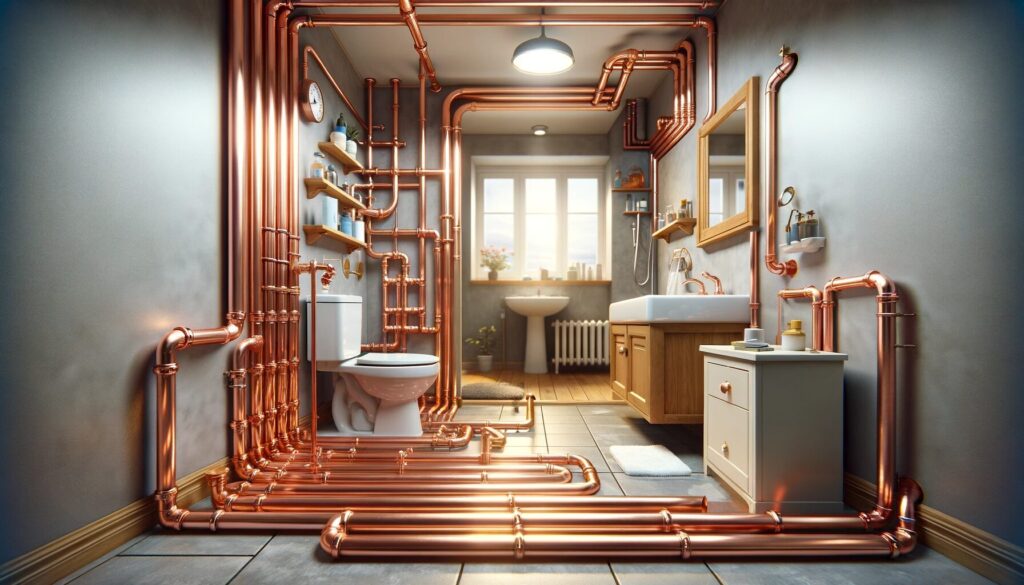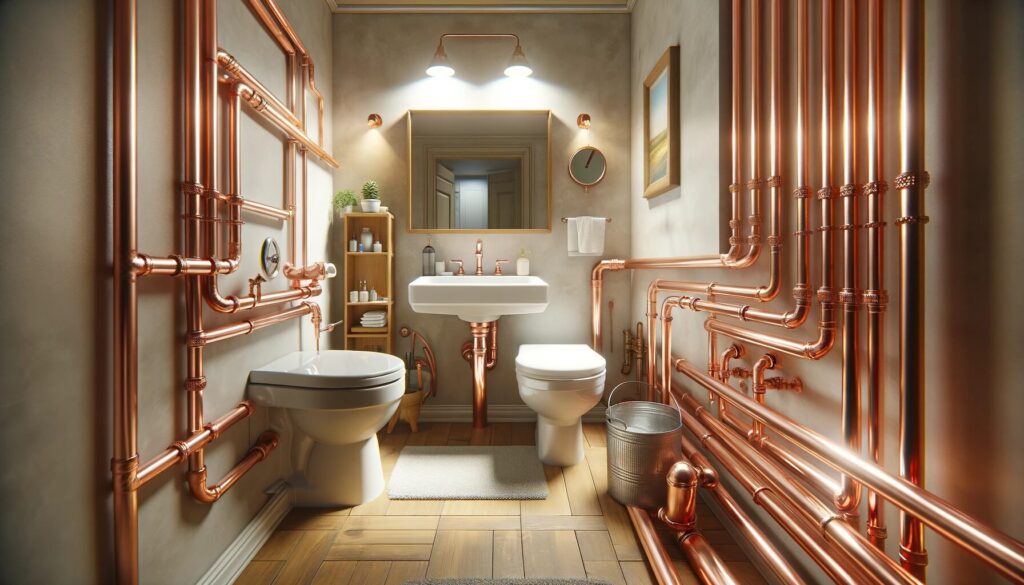Embarking on the world of home construction and renovation, we come across a pivotal component: copper pipes. These aren’t just any ordinary pipes, they are integral in establishing a robust and reliable plumbing system, whether in a cozy home or a towering skyscraper. Their significance stretches across the spectrum, catering to the enthusiastic DIY homeowner as well as the seasoned construction professional. Understanding the nuances of copper pipes is akin to grasping the essentials of good craftsmanship. These pipes are not just conduits for water, they’re the arteries of any well-built structure, ensuring efficiency and longevity.

An Overview of Copper Pipes
Copper pipes, in their gleaming, reddish-brown glory, are more than just a plumbing material. They are a testament to durability and versatility. Let’s delve into what makes copper pipes a preferred choice:
- Durability: Copper pipes boast impressive longevity. They resist corrosion and withstand the test of time, much like a well-constructed foundation. They’re not just pipes, they’re a long-term investment.
- Versatility: Adaptable to varying temperatures, copper pipes efficiently manage both scalding hot and icy cold water. Their resilience to temperature fluctuations makes them an indispensable part of any plumbing system.
- Health Benefits: Copper, with its natural antibacterial properties, adds an extra layer of safety to your water supply, ensuring that health and hygiene are always at the forefront.
Types of Copper Pipes
In the realm of copper pipes, we encounter three distinct types, each with its specific role and characteristics:
- Type K: The robust one. With walls thicker than its counterparts, Type K is the go-to for situations demanding extra strength and durability. It’s the workhorse of the copper pipe family, often found in main water lines and underground installations.
- Type L: Striking a balance between thickness and flexibility, Type L is the middle ground. It’s the versatile choice for residential plumbing, adept at handling the demands of everyday use.
- Type M: The lightweight contender. Type M, with its thinner walls, is cost-effective and suited for lower pressure and less demanding applications. It’s the economical choice for projects where budget constraints are a consideration.
Type M vs. Type L Copper Pipes
In the arena of copper pipes, the comparison between Type M and Type L is like weighing two reliable workhorses, each with its distinct strengths. Here’s how they stack up.
Type M Copper Pipes:
- Characteristics: Type M pipes are recognized for their thinner walls, offering a lightweight solution for plumbing needs. They’re economical yet reliable, akin to a trusty tool that does its job without fuss.
- Ideal Usage: These pipes shine in low-pressure scenarios. They are commonly used in residential settings for cold water lines or modest heating systems. Think of them as the reliable sedan of the plumbing world – not flashy but dependable and cost-effective.
- Practical Advice: In renovation projects, especially in older homes where space and budget are concerns, Type M pipes offer a practical solution. They are easier to handle and install in constrained spaces.
Type L Copper Pipes:
- Characteristics: Type L pipes boast thicker walls, equating to greater durability and resilience. They’re the pickup truck of copper pipes – robust and versatile.
- Ideal Usage: These pipes are well-suited for both hot and cold water lines in residential buildings. They’re particularly advantageous in systems that experience higher pressure or temperature.
- Practical Advice: The initial cost might be higher than Type M, but consider Type L as a long-term investment. It’s akin to choosing a tool that might cost more but offers durability and fewer maintenance issues in the long run.
Choosing Between the Two:
The decision boils down to the specific requirements of your project. Type M is apt for lighter, budget-sensitive tasks, while Type L is your candidate for more demanding scenarios. It’s a matter of matching the pipe to the job’s nature – similar to choosing the right type of nail for a particular wood.

Specialty Copper Pipes and Fittings
Venturing into the specialty realm of copper pipes and fittings, we find options tailored for specific functions.
Refrigeration Copper Pipes:
- These pipes are designed specifically for refrigeration and air conditioning systems. They’re manufactured to be internally clean, ensuring no impurities interfere with the system’s operation.
- Key Point: It’s crucial to use the correct type of pipe for specific applications. Using a standard plumbing pipe in an A/C system is a misstep that can lead to inefficiencies and potential failures.
DWV Copper Pipes:
- DWV – standing for Drain, Waste, and Vent – these pipes are the unsung heroes in the plumbing system. They’re robust, designed to handle the less glamorous but essential part of plumbing.
- Usage: Thicker and more substantial, they are engineered to withstand the rigors of waste and vent systems.
Fittings:
- Fittings are the crucial links that connect your pipe layout. They come in various forms – elbows, tees, connectors – each serving a specific purpose in the plumbing network.
- Important Note: Always ensure that the fittings are compatible with the type of copper pipe used. A mismatch can lead to weak points in the system, potentially causing leaks.
Insight: When assembling a copper piping system, approach it with the precision of a craftsman. Ensure that each piece fits seamlessly with the next, and don’t compromise on the quality of your fittings. A well-executed job not only stands the test of time but also reflects the skill and attention to detail of the builder.
Installation Tips and Best Practices
When it comes to installing copper piping, precision and attention to detail are paramount. Here’s how you can achieve a professional finish, based on decades of hands-on experience.
Cutting Copper Pipes:
- Choosing the Right Tool: Opt for a high-quality tubing cutter. This ensures a clean, square cut without pinching or deforming the pipe.
- The Cutting Process: Rotate the cutter around the pipe, tightening it incrementally. Patience is key – a rushed job can lead to uneven cuts.
Soldering Copper Pipes:
- Preparation: Clean both the pipe and fitting meticulously. This can’t be overstressed – proper cleaning ensures a strong, leak-free joint.
- Flux Application: Apply flux evenly to both surfaces. Think of flux as the foundation – essential for a solid build.
- Heating and Soldering: Heat the joint evenly, then introduce the solder away from the flame. The heat should draw the solder into the joint, creating a capillary action. It’s a delicate balance – too little heat won’t draw the solder, while too much can damage the pipe.
Safety Precautions:
- Essential Gear: Never underestimate the importance of gloves and safety goggles. Molten solder and flux can cause severe injuries.
- Adequate Ventilation: Soldering can produce harmful fumes. Ensuring good airflow in your workspace is not just a safety measure, it’s a necessity.
Avoiding Common Mistakes:
- Overheating: An overheated joint can ruin both the pipe and fitting. Learn to recognize the right temperature for soldering.
- Avoiding Cold Solder Joints: A common issue with beginners is a ‘cold solder’ joint, where the solder doesn’t properly melt and bond. Reheat and resolder if you suspect this issue.
Maintenance and Longevity of Copper Plumbing
A well-installed copper plumbing system can last generations. Here’s how to ensure longevity.
Lifespan Considerations: Properly installed copper plumbing can last upwards of 50 years. The key is in the quality of materials and the precision of installation.
Maintenance Essentials:
- Regular Inspections: Look out for signs of corrosion or wear. Catching issues early can prevent major repairs down the line.
- Managing Water Quality: Hard or acidic water can accelerate wear on copper pipes. Consider installing a water softener if your water quality is less than ideal.
Corrosion Prevention:
- Proper Installation Practices: Avoid direct contact with dissimilar metals to prevent galvanic corrosion.
- Insulation: Protect pipes from extreme temperatures and condensation.
FAQ Section
For indoor plumbing, balance factors like water pressure, adherence to building codes, and cost. Generally, Type L is a sound choice for its durability and moderate price point, especially in residential settings.
While Type M can be used for hot water, its thinner walls make it more susceptible to heat-induced wear. It’s acceptable for lower temperature and pressure settings, but always consult local building codes and manufacturer guidelines.
Rigid Tubing: Ideal for straightforward, direct runs. It’s more durable but requires more skill in handling and installation.
Flexible Tubing: Offers ease of installation in complex layouts or tight spaces, though it may be more expensive and less robust in some situations.
Recommendation: Use rigid tubing for main lines where durability is key, and flexible tubing for areas requiring more adaptability.
Yes, copper piping is safe and commonly used for drinking water. Its antimicrobial properties and lack of harmful leaching make it an excellent choice for potable water systems.
Copper pipes typically last between 50 to 70 years, depending on factors like installation quality, water quality, and environmental conditions. Regular maintenance and water treatment can extend their lifespan.
